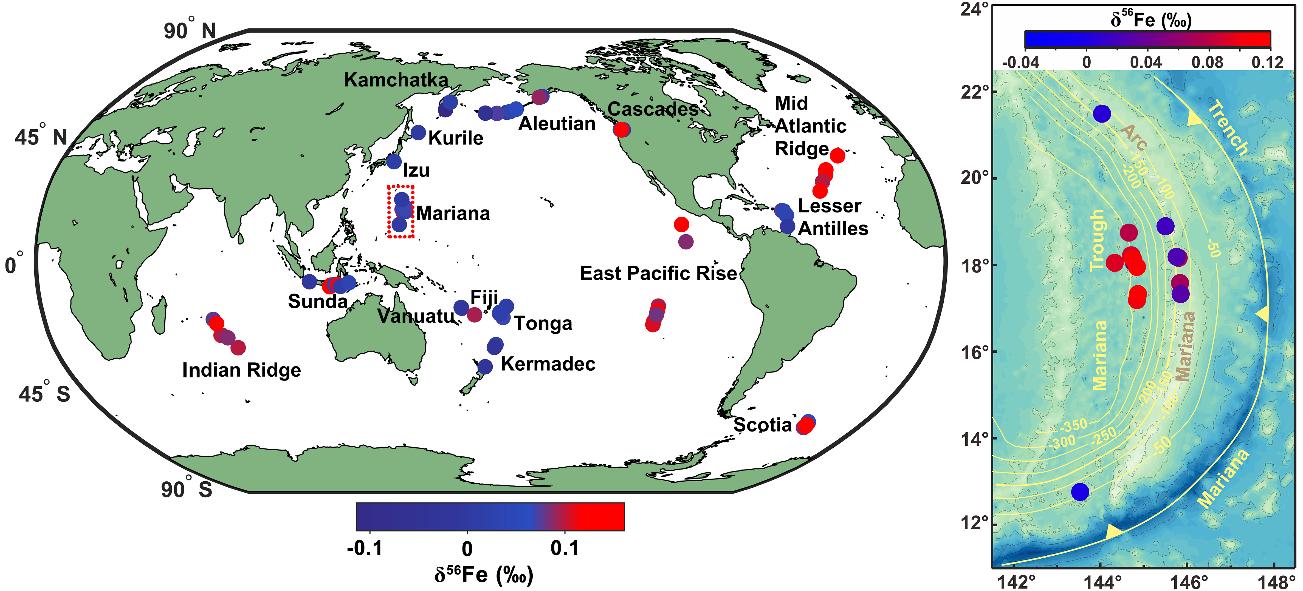
Arc basalts typically have higher Fe3+/∑Fe ratios but lighter Fe isotopic compositions than mid-ocean ridge basalts (MORB). However, the reasons for these differences are unclear.
In order to explore the role of serpentinite dehydration in sub-arc mantle oxidation, Dr. CHEN Zuxing of Prof. ZENG Zhigang's team from the Institute of Oceanology of the Chinese Academy of Sciences (IOCAS) and his collaborators reported new Fe isotope data for fresh lavas from the Mariana subduction zone, along with available Fe-B-Sr-Nd isotope and B/Nb ratio data for global arc basalts.
The study was published in Geochimica et Cosmochimica Acta on Dec. 7.
The researchers found that the studied Mariana Arc basaltic lavas had lighter Fe isotope compositions than the MORB-like δ56Fe values of the middle Mariana Trough basalts, which indicated that they were similar to other arc basalts from cold subduction zones in the west Pacific.
They also found that the δ56Fe values of global subduction zone basalts were correlated with geochemical proxies for the addition of serpentinite-derived fluids (i.e., B isotopes and B/Nb ratios). "Based on these evidences, we believe that the serpentinite-derived fluid contribution has a primary control over the across-arc Fe isotope variations and isotopically light Fe in global arc basalts from cold subduction zones," said Dr. CHEN.
Theoretically, the Fe2+–SOx bearing fluids released by dehydration of subducted slab serpentinites or dragged-down forearc serpentinites at sub-arc depths have extremely light Fe isotope compositions. If the sulfate-rich fluids contain adequate Fe to metasomatize the sub-arc mantle, it can cause light Fe isotope compositions and high Fe3+/∑Fe ratios in arc basalts.
Alternatively, as the forearc serpentinites are characterized by higher Fe3+/ΣFe ratios and significant Fe isotope fractionation with low values down to -0.26‰, directly melting the mélange containing dragged-down forearc serpentinites can produce arc magmas with light Fe isotopes and high Fe3+/∑Fe ratios.
"Overall, the contribution of serpentinite components to the sub-arc mantle can account for the decoupling of Fe3+/∑Fe and δ56Fe in global arc magmas," said Dr. CHEN.
The fluid metasomatism model requires a high Fe content in the fluids (e.g., several wt.%), which necessitates additional experiments to determine whether this high Fe mobility in sulfate-rich fluids is applicable during serpentinite dehydration.

Fe isotope variations in global subduction zone basalts and MORB. (Image by IOCAS)

86-10-68597521 (day)
86-10-68597289 (night)

52 Sanlihe Rd., Xicheng District,
Beijing, China (100864)

